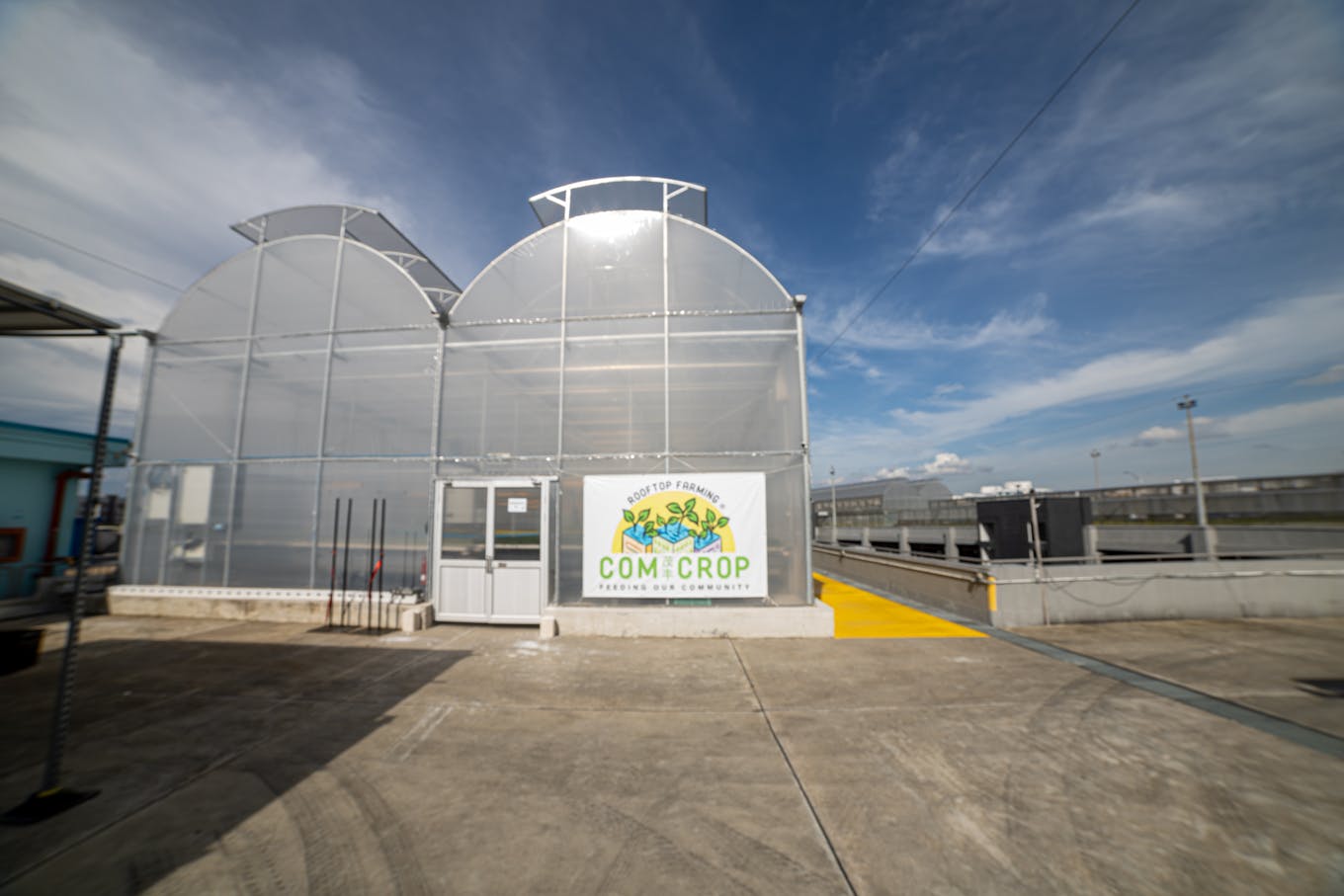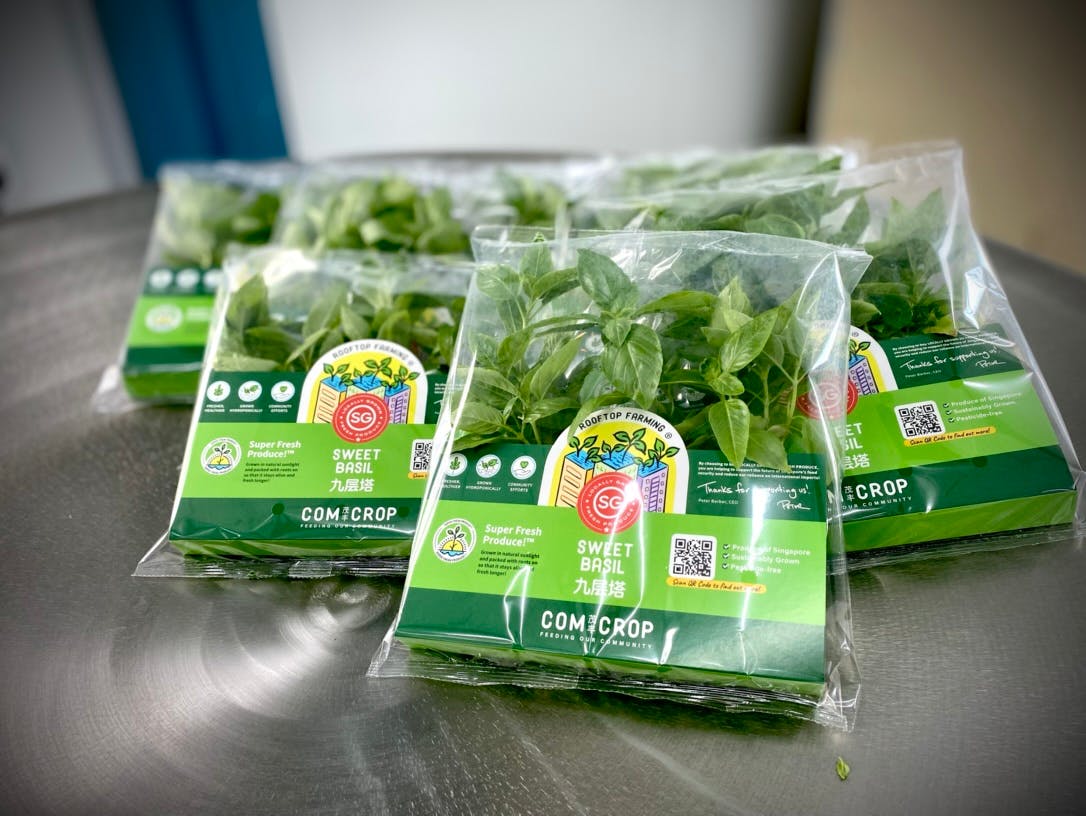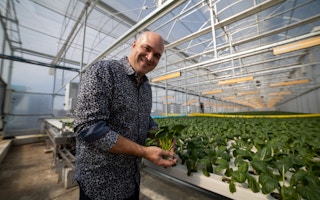Having grown up in a farming area located in Central Victoria, about a three-hour drive from Melbourne, ComCrop’s chief executive Peter Barber knows about the challenges to make ends meet as a farmer.
To continue reading, subscribe to Eco‑Business.
There's something for everyone. We offer a range of subscription plans.
- Access our stories and receive our Insights Weekly newsletter with the free EB Member plan.
- Unlock unlimited access to our content and archive with EB Circle.
- Publish your content with EB Premium.
“No one makes any money from farming then, because all the money was spent on distribution and logistics. The supermarkets get a 30 to 40 per cent cut and the farmers there earn very little,” he said.
The Australian state of Victoria in the 1970s which Barber knew, with rolling hills of rural farmland used for cattle and crops, left a deep impression on him for how hard it is for the agricultural industry to thrive.

ComCrop’s new hydroponics greenhouse is located on a rooftop of a building in an industrial estate. Image: Firdaus Firlany / Eco-Business
Barber now works in a very different environment. In land-scarce Singapore, he heads ComCrop, a pioneer in building urban farms on the unused rooftops of buildings. Taking advantage of the natural sunlight on the roofs instead of using artificial light indoors, the company manages to keep production costs low for its farms, and ensure a viable business model.
ComCrop’s latest venture is a hydroponics greenhouse facility on the concrete rooftop in the Woodlands East Industrial Estate in northern Singapore, producing leafy greens such as lettuce, basil, and local favourites such as “chye sim”. It supplies its produce to about 40 NTUC Fairprice supermarkets across the island on a daily basis.
The farm, its first enclosed greenhouse, is on track to produce more than 20 tonnes of greens in a month, compared to the same amount in a year for its previous set-ups, which include outdoor herb farms.
Barber is optimistic about the possibilities of further expanding the agricultural sector in the island state, a place that he has called home for almost 30 years.
The Singapore government is backing a “30 by 30” initiative to build up the agri-food industry’s capabilities and capacity to produce 30 per cent of its people’s nutritional needs by 2030, but Barber feels the country can go further and set its sights on becoming a net food exporter if it is serious about enhancing its food security and resilience.
In this interview with Eco-Business, he shares what he thinks is lacking in the current food production ecosystem, why we should be wary about large foreign players venturing into the high-tech farming space, and why Singaporeans should buy local produce.
ComCrop has made some significant strides in increasing its yield and now you have a new rooftop vegetable farm. What helped the expansion?
We did not always plan to expand rooftop farming. We were going to continue doing it at the scale we were going at previously. But Covid-19 happened. What woke everyone up was when the [Johor-Singapore] Causeway closed and about 40 per cent of the supply of fruits and vegetables from Malaysia was cut off overnight.
The supermarkets panicked. We were already doing business with them, but not at a volume that they needed when the crisis happened. All of a sudden these supermarkets and retailers realised that we were able to help them.
At around the same time, Singapore launched its “30 by 30” initiative. The Singapore Food Agency had put out a list of criteria, and they were asking us: can you tick all these boxes? The aim was for existing projects to rapidly expand what they were already doing, so that food production can be scaled up quickly.
A part of the state programme looked at partial funding towards capital expenditure, so that helped us to purchase the technology [for automation] needed to make things more productive per square metre. We could then hit the targets that the Singapore Food Agency had requested for.
“
If the borders shut again, the stuff that is leaving can then stay. The production capacity needs to already be in place, because you cannot just expect turn a farm on, and say: Can I have some fish? Can I have some eggs?
Did the government support matter a lot?
People seem to think that with the “30 by 30” initiative, there are government subsidies, but it is not like that. We have to compete as a business against our local and international competitors. We need cost-effective solutions.
Of course, it might be easy to compete with produce coming from Australia, the Netherlands, United Kingdom or the United States, because all these are coming in by plane and they are expensive, right? But it is a challenge to compete against Malaysia, Thailand and China. Fortunately, against our regional neighbours, we can now match their produce prices. Although we are not allowed to use the word “organic”, our produce is also pesticide-free and our standards are right up there.

Peter Barber says hydroponic greenhouses are not the only solution to enhancing Singapore’s food resilience. ComCrop’s strategy should only be part of the entire picture. Image: Firdaus Firlany / Eco-Business
What is your assessment of Singapore’s ecosystem of food production, especially after the authorities are backing it with the “30 by 30” initiative? What are the opportunities and challenges that lie ahead?
Of course hydroponic greenhouses are not the only solution [to enhancing our food resilience]. I see our strategy as part of the entire picture. In the future, there should be high-technology greenhouses, and a mixture of indoor farms and soil-based farms. But if we truly want food security, we have to go way beyond locally producing 30 per cent of our food needs by 2030.
We should become a net food exporter. We would have built a functional ecosystem if we can do that cost effectively. If the borders shut again, the stuff that is leaving can then stay. The production capacity needs to already be in place, because you cannot just expect to turn a farm on, and say: Can I have some fish? Can I have some eggs? Our food producers need to become a part of the whole value chain, and ask: Why can’t Malaysia become our customer? What can we start to do so that it goes the other way around? There would be some things that we can do better than Malaysia. For example, technology. If Malaysia was to seriously look at their agriculture industry, they would realise that they also need to figure out how to modernise that, because now it has gone down a certain path far enough and they are going to hit a brick wall. They have to make some drastic changes.
Singapore has been able to modernise because we have come to a point where we basically have no agriculture industry at all. We are literally starting from scratch. It was our biggest challenge when I started building this rooftop greenhouse back in 2018. It was so hard trying to get suppliers to even talk to us. The Dutch won’t answer their telephones. The Japanese, too. The Americans would sell anything to anybody, so we worked with them, and there were smart people who understood what we were doing, and were willing to help. It cost us a fortune, because we had to ship everything from California, fly their personnel in so they could help us set it up. There were also automated systems coming in from Belgium, irrigation systems coming in from Spain, and we had to deal with integrating them, as well as with the supply chain disruptions. It was only when the Singapore authorities started saying that, look, we are going to build an agriculture industry here, that people started paying attention, and all of a sudden the money was coming to Singapore.
On your point about the need to push beyond the “30 by 30” vision and become a net exporter, do you think this is on the minds of the key decision makers too?
I think they would be very nervous about making any claims beyond the current targets, because those are already a big step.
For food producers like us, however, we should think big. There are exciting things happening in this space right now. Singapore is in a unique position where it is creating intellectual property, technology and workflows that have never been created before. It gives us a good opportunity to be in the leading position. We need to be this tiny country that feeds Asia and the world. It is a bold statement, but it can be done. For the past 50 years, economic growth was a priority for Singapore and look how well we did. If we put in the same level of professionalism and resources into building the agricultural sector like how we have done it for other sectors, we can make it happen.

ComCrop sends its produce to a local supermarket chain on a daily basis. Image: ComCrop
Can urban farming really feed Asia?
For us, we went down the path of urban farming to be environmentally sustainable – which still is the core DNA of the business – and also be as efficient as possible, to make sure that this is a financially viable business. It is not just about scaling up or throwing big money at building a big site. You have to make sure that costs are maintained.
In a way, cost is the biggest problem facing the “big guys” now, for example the indoor farming ventures. The technology might be very smart, and if it was economically viable, I would also be doing it since everything can be controlled. But the electricity bills are a killer, because of the lighting, which has become more expensive. Here, at the hydroponics greenhouse, I can offset this with solar capture, hopefully completely by early next year.
Of course, they are not doing anything wrong. They are doing what they have to do, but this business model is hurting now. How much will their produce cost on the shelf? You could improve a product and want to sell it for say $150, but the consumer might only be willing to pay $5 for that product at the end of the day. So businesses have to understand what they are trying to do.
Let me illustrate why I think people still don’t really understand industrial urban farming. During the pandemic, I took a course on urban farming, and I realised that it was focusing on all the wrong things. Urban farming on an industrial scale is supposed to offset our reliance on imported food. Farmers need to become part of the existing distribution network, but the course content was more about community farm growing. Sure, if you want to start a farm in a housing estate and feed about 10 people, that is great but it is not economically viable. Industrial-scale production is if you can grow for yourself and somehow still share the food with everybody else.
Also, if I have to start buying trucks and deliver to individual units, that is going to be a hipster business. But there are a few farms here that behave like that. They buy seven things from somewhere else and only grow three things, fill a basket and overcharge the consumer for it. That is not fixing food security. Growing kale at S$70 (US$49) a kilogram will not solve the problem.
You mentioned money coming into Singapore. In the high-tech farming space, we are now seeing proprietary technologies being brought in from different parts of the world, but how much of a game-changer is this? Could it be all hype?
Let me share a story. A certain very large vertical farm company was invited by a Singapore funder to come visit Singapore one day, and I got a phone call and it was them saying that they wanted to visit one of our greenhouses. During the visit, the visitor was very arrogant, almost Jeff Bezos-like, but when he saw the price of the produce on our shelves, at about S$2.95 (US$2.08) a pack, he paused. He said he would not be able to do that.
And this is a point that I would like to make: we are putting money into these guys and these foreign technologies, but they are not thinking right because they are so focused on their technology. If you have done research, you would know that many of these big indoor vertical farming companies, especially the ones in America, are pretending that they have got some IP, but it’s all nothing new. It could be just that they have unique IP for a particular site. It could basically be just a lie.
Now I think what we need to ask is: how can we have these big guys come in and have a conversation with us, work together with us, but not come in with the jackboots and step on the industry that we are trying to build. I know there are certain agencies here whose mandate is just to bring people in, but we need to bring in the foreign talent and technologies that will create synergy, not damage the industry.
My biggest concern is that eventually the venture capitalists that are supporting these types of companies with the flashy powerpoint presentations and impressive spreadsheets are going to figure that out, and they might see it as the problem with the entire industry. They would be asking: why is it that we have thrown so much money at you and you’re still not making money?
Moving forward, what would be an ideal business model that is cost-effective and sustainable for ComCrop?
We would want to build more of these rooftop greenhouses but in better locations. For example, build near the distribution centre of the supermarkets.
It is the problem that the farms on Neo Tiew Road [in the Northwestern part of Singapore where farms are concentrated in] face. Nobody lives there so no one would work on the farm and you will need to bring in foreign labour. We would want to operate in neighbourhoods where people who live right across the road from the farm can be hired.
We are also aiming to hire people who are more senior or semi-retired, because this is not a difficult job and we can train our employees. Actually, I like to hire “aunties” [an affectionate term in Singapore for middle-aged or elderly women] because they are very quality-conscious. The most time-consuming part of this job is for them to pull off the leaves that are not very nice, and that is what “aunties” are best at. They are also consumers themselves, and they know what consumers want.
We also need to have a dedicated market, especially when there comes a day when there is no more government funding. We need to know who is our buyer and have an agreed contract. We should not need to figure out who we are going to sell to.
“
If I have to start buying trucks and deliver to individual units, that is going to be a hipster business. But there are a few farms here that behave like that. They buy seven things from somewhere else and only grow three things, fill a basket and overcharge the consumer for it. That is not fixing food security.
Why should Singaporeans buy homegrown produce?
I remember that when our greenhouse was up and running, and we told NTUC Fairprice [the supermarket chain to which ComCrop sells its produce] that, they were doubtful. You could see that they have heard this song before, because previously, the farming sector had not been consistent in production. Everything was sporadic. That is where the industry has to mature to instill confidence. We have already done it with eggs, we are trying to get there with fish, and we need to do the same thing for vegetables.
And the reason why I’m making a lot of noise to get Singaporeans to buy local is not because we cannot sell our produce. In fact, we are sold out every day. But we need to educate the consumer that they have to support the entire ecosystem, whether they are buying from us or from another local farm, because only then will the supermarkets take note of the demand signals. They will start saying that they do not need to order that much from Malaysia or Australia, and that they are going to buy from us. That is how we slowly fix the problem.
Correction note: Barber was quoted as saying that growing kale at S$7 (US$49) a kilogram will not fix the food security problem in an earlier version of the story. The correct figure should be S$70.

















